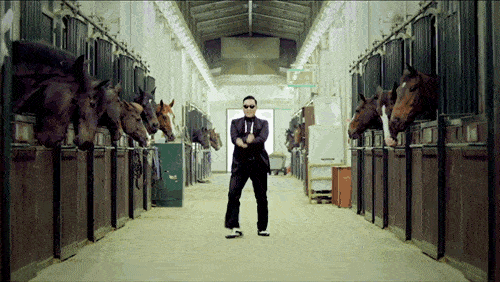I walked into my Jesuit community a week ago to find three of my brothers dancing. Not just moving in place dancing, but real, shake-it, dancing. They were watching a music video, grins pasted all over their faces and their hands crossed as if holding imaginary reins, they were galloping in place like… wait a minute, what year is this, 1986? Why am I using words to describe this? They looked like this:
It was ridiculous(ly awesome).
Now as my friends will attest, I am a self-professed music snob: pop and I do not often get along. But what with the dancing (and the subsequent laughter caroming around the house) it was pheremonally-impossible for me to turn my nose up at the thumping bass line and grinding, wind-up synth we were hearing. Psy had done it, I’d been Gangnam styled.
Like Beiber and Britney, Psy’s Gangnam Style demands to be played over and over again until your ears have OD-ed on cotton candy pop. So when mine started melting and the volume got turned down I turned to the Korean Jesuits (what’s up Ohchang Kwon and Sejin Ahn?! What’s up Junseong Park?!) I live with and asked the logical question: what is he saying?1
Their explanation, that in his crazy Gangnam video Psy was mocking the ultra-rich members of the section of Seoul known as Gangnam (Korea’s 90210 zip code), is remarkably similar to one given by Max Fischer over at the Atlantic:
“It turns out that the video is rich with subtle references that, along with the song itself, suggest a subtext with a surprisingly subversive message about class and wealth in contemporary South Korean society.”
Having lived with Koreans for a couple of years, I’d had the chance to hear how quickly capitalism, competition and materialism had infiltrated, and drastically changed, their country within the last four or five decades. My Korean Jesuit brothers told me that when Koreans think of Gangnam they most often think of all of that excess, all of that consumerism, all of that change (Fischer calls the area “the embodiment of South Korea’s one percent”).
My buddy Sejin Ahn, SJ told me that, traditionally, when Koreans move to a new place they were expected to bring rice cakes as a gift signaling their openness to their neighbors. This kind of traditional gift giving is something that doesn’t happen very often in 2012. He concluded by saying that “Gangnam itself is a kind of symbol of how individualistic, how separate from your neighbors, parts of Korea have become.” But that’s not all of Gangnam, according to Ohchang Kwon, SJ. “Just like wealthy parts of the U.S.,” he said, “Gangnam is double edged. Because it’s also the place where some of the best education in Korea is offered. So, while some people laugh at the excess of Gangnam, many others want the education, and the safety, and the successful lifestyle Gangnam represents.”
Korean cultural observer Adrian Hong, whom Fischer quotes in his piece, agrees with them.
“Koreans have been kind of caught up in this spending to look wealthy, and Gangnam has really been the leading edge of that,” Hong says. “I think a lot of what [Psy] is pointing out is how silly that is. The whole video is about him thinking he’s a hotshot but then realizing he’s just, you know, at a children’s playground, or thinking he’s playing polo or something and realizes he’s on a merry-go-round.”
My brothers’ explanation softened the guilt my music-snob-self felt for loving Gangnam Style. If I’m going to fall head over heels in love with a sugar-and-spice-and-everything-nice pop song, I said to myself, I’m glad it’s one with a hidden social critique… even if my ears didn’t know it at first.
— — — — —
- If you don’t speak Korean you can find out for yourself by watching the English translation of the video, provided by blogger Jae Kim. Her insightful blog entry about the song is worth reading in and of itself. ↩



